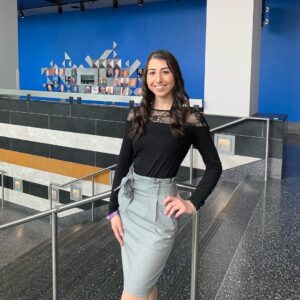Stefanie Konboz ’20 : On becoming an occupational therapist
During January break in her junior year of college, Stefanie Konboz ’20 discovered that she wanted to become an occupational therapist. As a biology major at Caldwell, she had originally thought she might become a physician assistant, but her professor, Dr. Agnes Berki, saw something in her and suggested she try an internship in occupational therapy. So she did, at P.G. Chambers School in Cedar Knolls.

“And within two days of that internship, I knew that that was exactly what I wanted to do,” said Konboz. Her supervisor at PG saw it too, telling Konboz that information can be taught but passion cannot. She said, “That has to come from within … you really have it,” explained Konboz, who recently passed her national board licensure examination and is officially an occupational therapist.
Konboz took the ball at the internship and ran with it, working at the job every day during break and ramping up her hours. Science Professor William Velhagen, Ph.D., helped her adjust her courses to make sure she maintained the trajectory to get into graduate school for occupational therapy. Konboz was accepted into all three New Jersey OT grad schools, picking Kean University. Classes during the first year, which focused mainly on theoretical subjects, were held online due to the pandemic. In the second year she was able to gain hands-on experience through labs at Kean’s on-site OTC clinic, a free service for children and adults.
While a full-time graduate student, Konboz was also a full-time patient, receiving OT due to nerve damage from car accidents. That experience, along with being a cancer survivor, has given her insights, resilience and an “innate desire” to reach out to people. “Even if they’re not exactly asking for it, if I see that they are struggling … I’m always trying to help out in any way possible because I’ve been in that situation where I was struggling physically,” said Konboz.
Her firsthand experience has shown her that occupational therapists are invaluable to the healing and recovery processes, mental and physical. Everything the therapist does in the session is done “with purpose” from “your physical positioning to your words of encouragement—‘a therapeutic use of self’ is what we call it,” explained Konboz. She said she is trained to look at all aspects of a patient’s life—physical, mental, emotional and environmental—to ascertain what can be adjusted to make life as functional and successful as possible.
As a recent graduate, Konboz is open-minded about her career path, but there are two areas she particularly likes: hand therapy and pediatrics. The hand, she said, is “very specialized … we work with patients with carpal tunnel, fractures, wrists, finger injuries, arthritis, overuse from work.” She finds the process especially rewarding when treating children with disabilities. “When you work with them and make their environment as successful as possible, they thrive. I love seeing that.”
Konboz is grateful to Caldwell for setting her on a “firm, strong foundation” for graduate school and helping her gain the discipline in her studies she needed to succeed. “It’s really a full-time job being a student, and I saw my professors being passionate in everything … it really led me to choose my career path,” said Konboz. She will always remember how the Caldwell science faculty members not only taught but also guided students and cared about their career paths, which she said, plays a role in “who you become.” While an undergraduate she learned about responsibility and professionalism by holding leadership positions as: treasurer of the Health Professions Club, Success Networking team coordinator for the National Honor Society of Leadership and Success and in executive board positions.
Konboz is excited to take her experiences out into the workplace and to enjoy the journey: “It’s not where you end up that matters. I think it’s where you start and the whole process along the way.”

